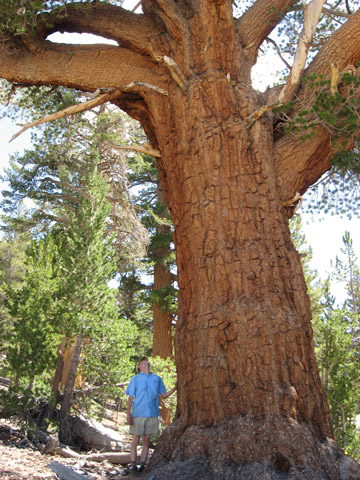Old, large trees may be even more important ecologically than long-believed, according to a new study in Nature. Looking at over half a million individual trees from over 400 species (both tropical and temperate), scientists have determined that most trees actually grow faster in their dotage than in their youth.
“In human terms, it is as if our growth just keeps accelerating after adolescence, instead of slowing down,” explains lead author Nate Stephenson with U.S. Geological Survey Western Ecological Research Center. “By that measure, humans could weigh half a ton by middle age, and well over a ton at retirement.”
Scientists have long-believed that as trees age their growth slows down, but the new study found that in fact 97 percent of trees (out of 403 species) see their growth speed up after maturity.
“Rapid growth in giant trees is the global norm, and can exceed 600 kg per year in the largest individuals,” write the researchers.
 Large western white pine (Pinus monticola) in California’s Sierra Nevada mountain range. Photo by: Rob Hayden. |
This comes with big ecosystem consequences: the older the tree the more carbon it sequesters every year.
“Large, old trees do not act simply as senescent carbon reservoirs but actively fix large amounts of carbon compared to smaller trees,” the scientists write, “at the extreme, a single big tree can add the same amount of carbon to the forest within a year as is contained in an entire mid-sized tree.”
Scientists have long recognized that old trees play important ecological roles, including niche wildlife habitat, fruit and flowers, and carbon storehouses, but the new study finds that these old trees are hugely-productive at sequestering carbon as well. However, these findings don’t necessarily translate to tree stands, since as tree stands age, individuals often perish, leaving fewer—albeit—larger survivors.
Old trees are vanishing worldwide. Not only are these often the first trees cut down by loggers, but they are also particularly vulnerable to drought and wildfires, both of which are thought to be occurring more frequently and intensely due to global warming. A study last year in Science warned that the world was at risk of losing its arboreal giants.
“Just as large-bodied animals such as elephants, tigers, and cetaceans have declined drastically in many parts of the world, a growing body of evidence suggests that large old trees could be equally imperiled,” the scientists wrote.

A large, old Scots pine (Pinus sylvestris) in the Sierra de Baza of southern Spain. Photo by: Asier Herrero.
Citations:
- Stephenson et al. (2013) Rate of tree carbon accumulation increases
continuously with tree size. Nature. doi:10.1038/nature12914 - David B. Lindenmayer, William F. Laurance, Jerry F. Franklin. Global Decline in Large Old Trees. Science 7 December 2012: Vol. 338 no. 6112 pp. 1305-1306 DOI: 10.1126/science.1231070.
Related articles
New Guinea animals losing vital tree cavities to logging, hunting practices

(12/17/2013) Across New Guinea, deforestation is occurring at increasing levels. Whether it be industrial logging, monoculture plantations, hunters felling trees in pursuit of arboreal wildlife, or other forms of forest conversion, deforestation is depleting not only forest carbon stocks and understory environments, but habitats for species who call tree cavities “home.” A new study in mongabay.com’s open-access journal, Tropical Conservation Science, evaluated whether a variety of man-made nest boxes could function as suitable substitutes for tree cavities.
Amazon’s vast rainforest dominated by few tree species

(11/12/2013) The Amazon rainforest is so vast, and so diverse, that seemingly simple questions— such as which species of trees are most common— remain unanswered. Researchers are finally seeing the forest and the trees after an international collaboration of 120 scientists teamed up to compile the largest tree survey ever assembled from the Amazon.
Recovering forests ‘heal’ themselves by speeding up nitrogen fixation

(10/08/2013) Nitrogen is colorless, odorless and tasteless, but all life on earth depends on it. Without it, our bodies cannot synthesize the nucleic acids that make up our DNA, or the protein-forming amino acids that are the very building blocks of our cells. Problematically, atmospheric nitrogen is relatively inert or nonreactive. This has created a unique biological dependency on a process called nitrogen fixation—where inert nitrogen from the atmosphere is converted into more reactive ammonia, a major component of soil fertilizers.
Climate change pushing tropical trees upslope ‘exactly as predicted’

(09/27/2013) Tropical tree communities are moving up mountainsides to cooler habitats as temperatures rise, a new study in Global Change Biology has found. By examining the tree species present in ten one-hectare plots at various intervals over a decade, researchers found that the proportion of lowland species increased in the plots at higher elevations. The study, which was undertaken in Volcan Barva, Costa Rica, adds to a growing body of evidence that climate change is having an impact on species range distributions.
Climate change could kill off Andean cloud forests, home to thousands of species found nowhere else

(09/18/2013) One of the richest ecosystems on the planet may not survive a hotter climate without human help, according to a sobering new paper in the open source journal PLoS ONE. Although little-studied compared to lowland rainforests, the cloud forests of the Andes are known to harbor explosions of life, including thousands of species found nowhere else. Many of these species—from airy ferns to beautiful orchids to tiny frogs—thrive in small ranges that are temperature-dependent. But what happens when the climate heats up?
World’s biggest owl depends on large old trees

(09/03/2013) The Blakiston fish owl (Bubo Blakistoni) is the world’s largest – and one of the rarest – owl species, with an impressive 6 foot (2 meter) wingspan. The giant owl, found exclusively in northeast Asia, shares its habitat with a menagerie of endangered and impressive animals, including Amur tigers, Amur leopards, Asiatic black bears and wild boars.
Palm oil drives Malaysian rainforest tree to extinction
(07/30/2013) Oil palm plantations have extinguished the last habitat of a rainforest tree in Malaysia. Last week the Forest Research Institute Malaysia (FRIM), a state agency, announced that the last stands of keruing paya (Dipterocarpus coriaceus) in Peninsular Malaysia were wiped out when Bikam forest reserve in Perak was cleared for oil palm plantations.